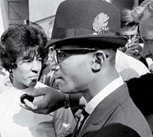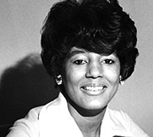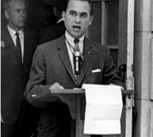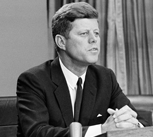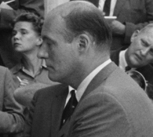
Autherine Lucy Foster became the first African-American student to enroll at UA in 1956. After she graduated from Miles College in 1952, she enrolled at the University as a graduate student in library science. Her brief stay on campus involved three days of tumultuous demonstrations. Foster was suspended and later expelled by the UA Board of Trustees.
In 1988, two professors invited Foster to speak at the University about the events that had occurred more than 30 years before. After her speech, faculty members persuaded the Board of Trustees to overturn her expulsion.
A year later, in 1989, Foster again enrolled at the University, where her daughter Grazia also was a student at the time. In 1992, mother and daughter graduated together — the former with a master's degree in elementary education, the latter with a bachelor's degree in corporate finance. A portrait of Autherine Lucy Foster now hangs in the Ferguson Center.
James Hood, a native of Gadsden, became involved with the Civil Rights movement through Dr. Martin Luther King, Jr.'s sister, his English teacher at Clark University in Atlanta, which he attended while waiting to enter college in his home state. At age 17, during the height of the Civil Rights movement, Hood and the NAACP sued UA to admit him. Federal courts ordered the University to desegregate; Alabama was the last state in the country to do so. Hood and Vivian Malone were admitted in 1963.
Hood left the University after two months, saying he wanted to avoid "a complete mental and physical breakdown." He transferred to Wayne State University in Detroit and graduated with a bachelor's degree, having studied political science and police administration. He returned to The University of Alabama and earned a doctorate in higher education in 1997. He is retired from Madison Area Technical College in Wisconsin.
Vivian Malone Jones was one of the two students whose enrollment Alabama Governor George C. Wallace attempted to block by positioning himself in the doorway of Foster Auditorium. In 1965, she became the first African-American student to graduate from the University, receiving a bachelor of arts in business management.
A native of Mobile, Jones earned a bachelor's degree at Alabama A&M, a predominantly African-American university, before it lost its accreditation. She then applied to UA's School of Commerce and Business Administration and was admitted as a junior. Upon her graduation, she joined the civil rights division of the U.S. Department of Justice.
She went on to become director of civil rights and urban affairs and director of environmental justice for the U.S. Environmental Protection Agency before her 1996 retirement. That year, she also was chosen by the George Wallace Family Foundation as the inaugural recipient of the Lurleen B. Wallace Award of Courage. In 2000, she was awarded a doctorate of humane letters from UA.
Jones died in 2005 from complications following a stroke.
On June 11, 1963, Alabama governor George Wallace came to national prominence when he kept a campaign pledge to stand in the schoolhouse door to block integration of the state's public schools. Wallace read this proclamation when he first stood in the doorway of Foster Auditorium to block the attempt of two black students, Vivian Malone and James Hood, to register at UA. The event became known as "The Stand in the Schoolhouse Door."
President John F. Kennedy federalized the Alabama National Guard and ordered its units to the University campus. Wallace finally stepped aside and returned to Montgomery, allowing the students to enter.
"If an American, because his skin is dark, cannot eat lunch in a restaurant open to the public, if he cannot send his children to the best school available, if he cannot vote for the public officials who represent him, if, in short, he cannot enjoy the full and free life which all of us want, then who among us would be content to have the color of his skin changed and stand in his place?" said then-President John F. Kennedy. Pointing out that unequal treatment was against American religious and Constitutional morals, he asked for a quicker end to discrimination and also promised new civil rights laws.
One week later, President Kennedy told Congress that the new civil rights laws he proposed involved every American's right to vote, to go to school, to get a job, and to be served in a public place without arbitrary discrimination – rights that most Americans now take for granted. The Civil Rights Act of 1963 had eight sections and included laws to guarantee all people would have equal access to hotels, restaurants, and other public sites. The act also helped to equalize black voting rights and end school desegregation.
On June 11, 1963, Nicholas deB. Katzenbach, then deputy attorney general of the United States, was a primary participant in one of the most famous incidents of the Civil Rights struggle. Alabama Governor George Wallace stood in front of UA's Foster Auditorium in an attempt to stop desegregation of that institution by the enrollment of two black students, Vivian Malone and James Hood. This became known as "The Stand in the Schoolhouse Door." Wallace stood aside only after being confronted by Katzenbach, accompanied by federal marshals and the Alabama National Guard. Katzenbach avoided a direct confrontation. He said to Mr. Wallace: "From the outset, Governor, all of us have known that the final chapter of this history will be the admission of these students."
A supporter of civil rights, Katzenbach oversaw departmental operations in desegregating the University of Mississippi in September 1962 and the University of Alabama in June 1963. He also worked with Congress to ensure the passage of the Civil Rights Act of 1964.
Frank Rose was president of the University from 1958 to 1969 and played an instrumental role in its desegregation on June 11, 1963. Having promised that he would ensure that federal laws were followed and that the campus would remain peaceful, he served as middleman between Governor George C. Wallace and the Justice Department of the Kennedy Administration.
Dr. Rose's tenure as UA president saw many other positive changes on campus. Enrollment almost doubled; graduate school enrollment increased tenfold; and the full-time faculty more than doubled. Dr. Rose also helped to boost the University's academic culture, working to recruit top students and faculty, raising undergraduate entrance requirements and committing to expanding programs for scholars.
Sarah Healy, UA's dean of women from 1954-1971, was instrumental in protecting Autherine Lucy, who in 1956 became the first African-American student admitted to UA, from the threat of violence by mobs of angry students. She provided her own car to escort Lucy on campus in an attempt to shield her from physical harm during Lucy's brief time at the University. Several years later, Healy also played an important role in the successful desegregation of UA, facilitating the enrollment of Vivian Malone and James Hood. She offered unwavering support to Malone during her course of study at the University.
John L. Blackburn, who was UA's dean of men in 1963, was deeply involved in the University's desegregation. Not only did he help to prepare African-American students Vivian Malone and James Hood for enrollment, but he also worked with University leaders to plan the course of events and try to preempt all possible problems. His efforts helped to ensure a peaceful desegregation of the University — facing federal authorities, Alabama governor George C. Wallace eventually removed himself without incident from the doorway of Foster Auditorium, through which he had tried to block Malone and Jones from entering.
UA's path to desegregation stretched over seven years, beginning in 1956 with Autherine Lucy's three-day stay on campus and culminating in 1963 with the peaceful enrollment of Vivian Malone and James Hood. Click on the images to read more about each person pictured and his or her role during this crucial period in UA's history.

